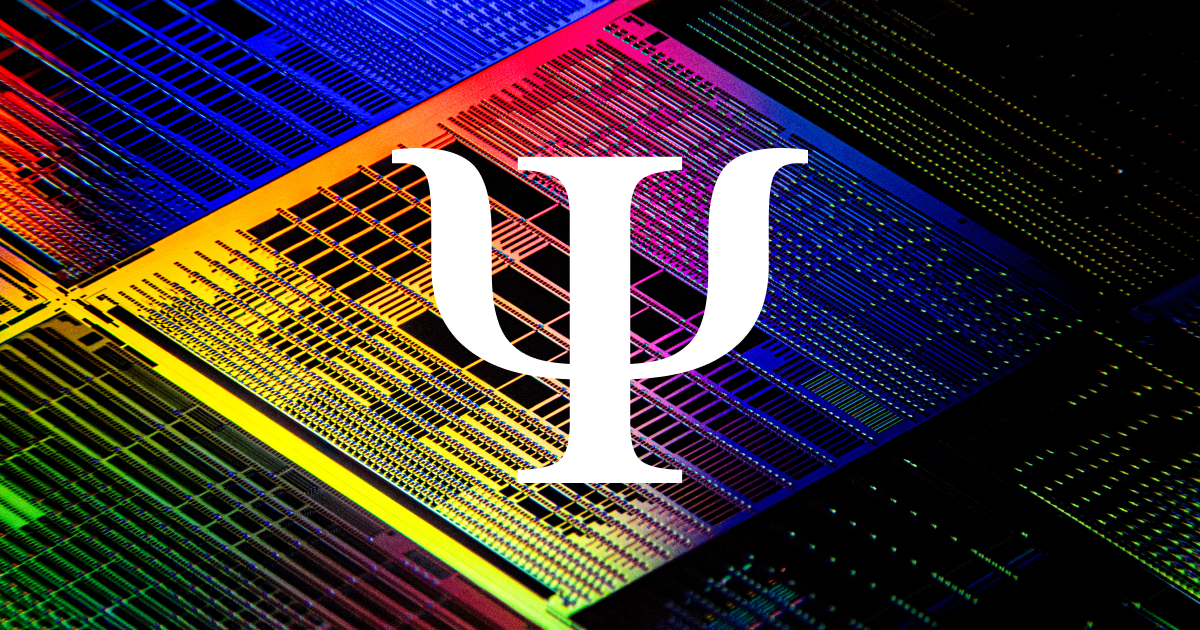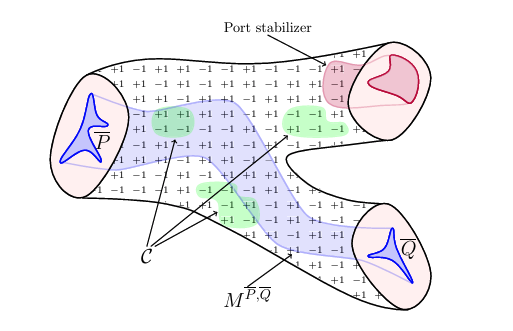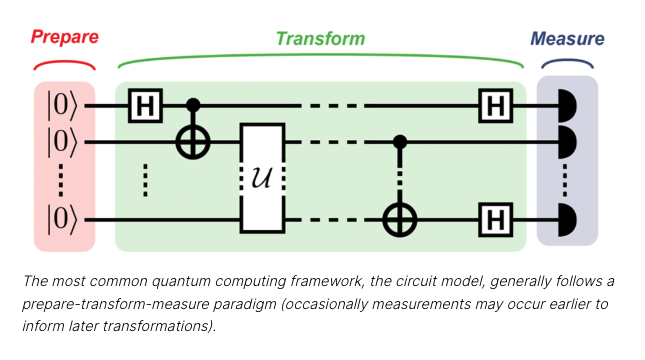
Simulating the Schwinger effect in 1+1 dimensions on a fault-tolerant quantum computer
Researchers from PsiQuantum have conducted a detailed analysis of quantum resource estimates (QREs) for studying the Schwinger effect (electron-positron pair production from background electric-field energy) in 1+1 dimensions. This was done by compiling two quantum-simulation algorithms for two relevant instances that were examined: (a) the quench of the electric field where the interaction is turned on at t=0 and electron-positron pairs start getting created, and (b) the scattering/splitting of an electron-positron particle pair that then travels through the lattice…

Blocklets
PsiQuantum presents a new, practical approach to fault tolerant quantum computing. The new approach, one particularly suitable for the high connectivity of photonic quantum computers, manages to achieve large checks but with fixed (small) hardware, leading to significantly higher performance.

Thinking inside the blocks: Fighting faults with a logical instruction set
How large does a useful quantum computer need to be?
This is an important but surprisingly hard question to answer.

PsiQuantum Announces Breakthrough in Architectures for Error-Corrected QuantumComputing
We recently announced a new approach to vastly increasing the efficiency of running quantum algorithms. We call it the Active Volume Architecture…

A world-first scalable framework for decoding, capable of supporting PsiQuantum’s first generation of fault-tolerant quantum computers.
Over the past three decades significant reductions have been made to the cost of estimating ground-state energies of molecular Hamiltonians with quantum computers….

Demonstration of an all-optical quantum controlled-NOT gate
The promise of tremendous computational power, coupled with the development of robust error-correcting schemes, has fuelled extensive efforts to build a quantum computer.
Author: J. L. O'Brien, G. J. Pryde, A. G. White, T. C. Ralph & D. Branning, Nature volume 426, pages 264–267 - Published: Nov 20, 2003

Optical quantum computing
In 2001, all-optical quantum computing became feasible with the discovery that scalable quantum computing is possible using only single-photon sources, linear optical elements, and single-photon detectors.
Author: Jeremy O'Brien, Science Vol. 318, Issue 5856 - Published: Dec 07, 2007

High-fidelity operation of quantum photonic circuits
We demonstrate photonic quantum circuits that operate at the stringent levels that will be required for future quantum information science and technology. These circuits are fabricated from silica-on-silicon waveguides forming directional couplers and interferometers.
Author: Laing et al. Appl. Phys. Lett. 97, 211109 - Published: Jun 17, 2010
All authors: Anthony Laing, Alberto Peruzzo, Alberto Politi, Maria Rodas Verde, Matthaeus Halder, Timothy C. Ralph, Mark G. Thompson, Jeremy L. O’Brien

Generating, manipulating and measuring entanglement and mixture with a reconfigurable photonic circuit
Entanglement is the quintessential quantum-mechanical phenomenon understood to lie at the heart of future quantum technologies and the subject of fundamental scientific investigations.
Author: Shadbolt et al. Nature Photon 6, 45–49 - Published: Dec 11, 2011
All authors: P. J. Shadbolt, M. R. Verde, A. Peruzzo, A. Politi, A. Laing, M. Lobino, J. C. F. Matthews, M. G. Thompson, J. L. O'Brien

Universal linear optics
Encoding and manipulating information in the states of single photons provides a potential platform for quantum computing and communication.
Author: Carolan et al. Science Vol. 349, Issue 6249, pp. 711-716 - Published: Aug 14, 2015
All authors: Jacques Carolan, Christopher Harrold, Chris Sparrow, Enrique Martín-López, Nicholas J. Russell, Joshua W. Silverstone, Peter J. Shadbolt, Nobuyuki Matsuda, Manabu Oguma, Mikitaka Itoh, Graham D. Marshall, Mark G. Thompson, Jonathan C. F. Matthews, Toshikazu Hashimoto, Jeremy L. O’Brien, Anthony Laing

Chip-to-chip quantum photonic interconnect by path-polarization interconversion
Integrated photonics has enabled much progress toward quantum technologies. Many applications, e.g., quantum communication, sensing, and distributed cloud quantum computing, require coherent photonic interconnection between separate on-chip subsystems.

Large-scale silicon quantum photonics implementing arbitrary two-qubit processing
Photonics is a promising platform for implementing universal quantum information processing. Its main challenges include precise control of massive circuits of linear optical components and effective implementation of entangling operations on photons.
Author: Qiang et al. Nature Photonics volume 12, pages 534–539 - Published: Aug 20, 2018
All authors: Xiaogang Qiang, Xiaoqi Zhou, Jianwei Wang, Callum M. Wilkes, Thomas Loke, Sean O’Gara, Laurent Kling, Graham D. Marshall, Raffaele Santagati, Timothy C. Ralph, Jingbo B. Wang, Jeremy L. O’Brien, Mark G. Thompson, Jonathan C. F. Matthews

Programmable four-photon graph states on a silicon chip
Future quantum computers require a scalable architecture on a scalable technology—one that supports millions of high-performance components. Measurement-based protocols, using graph states, represent the state of the art in architectures for optical quantum computing.
Author: Adcock et al. Nature Communications volume 10, Article number: 3528 - Published: Aug 06, 2019
All authors: Jeremy C. Adcock, Caterina Vigliar, Raffaele Santagati, Joshua W. Silverstone, Mark G. Thompson

Integrated photonic quantum technologies
Quantum technologies comprise an emerging class of devices capable of controlling superposition and entanglement of quantum states of light or matter, to realize fundamental performance advantages over ordinary classical machines.
Author: Wang et al. Nature Photonics volume 14, pages 273–284 - Published: Oct 21, 2019
All authors: Jianwei Wang, Fabio Sciarrino, Anthony Laing, Mark G. Thompson

Chip-to-chip quantum teleportation and multi-photon entanglement in silicon
Exploiting semiconductor fabrication techniques, natural carriers of quantum information such as atoms, electrons, and photons can be embedded in scalable integrated devices. Integrated optics provides a versatile platform for large-scale quantum information processing and transceiving with photons. Scaling up the integrated devices for quantum applications requires highperformance single-photon generation and photonic qubit-qubit entangling operations.
Author: Llewellyn et al. - Published: Nov 15, 2019
All authors: Daniel Llewellyn, Yunhong Ding, Imad I. Faruque, Stefano Paesani, Davide Bacco, Raffaele Santagati, Yan-Jun Qian, Yan Li, Yun-Feng Xiao, Marcus Huber, Mehul Malik, Gary F. Sinclair, Xiaoqi Zhou, Karsten Rottwitt, Jeremy L. O Brien, John G. Rarity, Qihuang Gong, Leif K. Oxenlowe, Jianwei Wang, Mark G. Thompson

Error protected qubits in a silicon photonic chip
General purpose quantum computers can, in principle, entangle a number of noisy physical qubits to realise composite qubits protected against errors. Architectures for measurement-based quantum computing intrinsically support error-protected qubits and are the most viable approach for constructing an all-photonic quantum computer.
Author: Vigliar et al. - Published: Sep 17, 2020
All authors: Caterina Vigliar, Stefano Paesani, Yunhong Ding, Jeremy C. Adcock, Jianwei Wang, Sam Morley-Short, Davide Bacco, Leif K. Oxenløwe, Mark G. Thompson, John G. Rarity, Anthony Laing

Sculpting noise with dynamical bias
Photonic qubits have the great advantage that they don’t easily interact with their environment and hence are intrinsically less noisy than many other qubit types…

Modular decoding: Scaling up by breaking down
There’s an unsung impasse currently facing commercially useful fault-tolerant quantum computers. Useful quantum computers rely on quantum error-correcting codes that redundantly encode otherwise delicate logical information into a much larger system of physical qubits….

Fusion Based Quantum Computing (FBQC)
We’re excited that our work on Fusion Based Quantum Computing (FBQC) has recently been published in nature communications…
